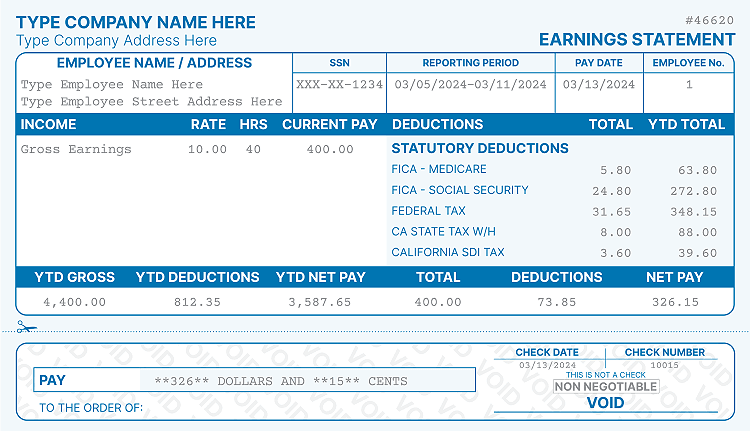What’s California State Disability Insurance – Employee (CASDI-E) on Paystub?

Have you ever noticed the CASDI-E line on your paycheck and wondered what it means?
This small deduction plays a big role in helping workers in California.
It provides financial support when you're unable to work due to illness, disability, or even when you need time to bond with a new child. According to Employment Development Department (EDD) report, California State Disability Insurance (CASDI) paid out over $8.4 billion in benefits last year alone, supporting hundreds of thousands of workers during challenging times.
In this article, we’ll break down what CASDI-E is, why you pay it, its examples and how it helps you during important moments in life.
What is CASDI?
CASDI, or California State Disability Insurance, is a statewide insurance program administered by the Employment Development Department (EDD).
The program consists of two main components:
- Disability Insurance (DI): Offers short-term wage replacement benefits to employees unable to work due to disability or pregnancy.
- Paid Family Leave (PFL): It provides benefits for employees who need time off to bond with a new child, care for a seriously ill family member, or manage military-related needs.
Need to Know: What is OASDI Tax?
What is CASDI-E?
CASDI-E, appearing on pay stubs, stands for California State Disability Insurance – Employee Contribution. It represents a payroll deduction from an employee's wages to fund California's State Disability Insurance (SDI) program.
The "E" in CASDI-E emphasizes that this contribution is made by employees, not employers. This deduction ensures financial support for eligible employees who are unable to work due to non-work-related disabilities, illnesses, or pregnancy and provides benefits under the Paid Family Leave (PFL) program.
Need to Know: What is Long-Term Disability (LTD)?
How CASDI-E Tax Works
The CASDI-E tax is a payroll deduction that ensures California workers have access to essential financial benefits during times of need. Entirely funded by employee contributions, this deduction appears as "CASDI-E" on pay stubs and supports both the Disability Insurance (DI) and Paid Family Leave (PFL) programs.
For 2025, the contribution rate is 1.2% of wages, with a significant change from prior years—there is now no wage cap. Previously, only a portion of income was taxed, but the removal of the cap means the 1.2% is deducted from the employee's entire earnings.
This adjustment follows the 2024 rate increase from 1.1% to 1.2%. These contributions create a state-managed fund that ensures benefits are available when workers file qualifying claims for disability or family leave.
Examples of CASDI-E in Action
Consider the case of Jane, a retail worker who experiences a severe back injury. Her regular paycheck includes a 1.2% deduction under CASDI-E, which funds her claim when she cannot work. Thanks to her contributions, Jane receives 70% of her weekly wages for 10 weeks, providing much-needed financial relief during her recovery.
Similarly, Carlos, a new father, takes six weeks off to bond with his newborn child. The same CASDI-E deductions from his paycheck allow him to claim Paid Family Leave benefits. He receives 90% of his regular income during this time, enabling him to focus on his family without the pressure of an immediate return to work.
These scenarios highlight the direct impact of CASDI-E contributions, offering peace of mind and financial support during life’s critical moments. By pooling these deductions into a shared fund, the system ensures that benefits are available when needed, reinforcing the value of this essential program for California workers.
Disability Insurance (DI) and Paid Family Leave (PFL) Statistics
The impact of California State Disability Insurance (CASDI) is evident in its ability to provide substantial financial support to workers facing temporary challenges. In 2023, the Disability Insurance (DI) program paid out a total of $8.4 billion in benefits. With an average weekly benefit amount of $783, over 755,000 claims were filed, highlighting the program's importance in helping employees during times of illness, injury, or pregnancy.

The Paid Family Leave (PFL) program also plays a crucial role in supporting workers who need time off for family-related reasons. In 2023, the program distributed $1.69 billion in benefits, with an average weekly benefit of $874 and an average claim duration of 7.18 weeks. Notably, around 44% of bonding claims were filed by male employees, indicating an encouraging trend of fathers taking a more active role in caregiving.
These statistics emphasize the reach and significance of CASDI-funded programs in maintaining financial stability for California workers during critical life events. Whether through DI or PFL, these benefits ensure that employees can focus on their health and families without the immediate burden of lost income.
Conclusion
CASDI-E tax is a critical mechanism enabling California's employees to access benefits during personal or family crises. By funding Disability Insurance and Paid Family Leave programs, it ensures financial stability and work-life balance. With updated rates and growing participation, CASDI continues to serve as a model for employee-centric state insurance programs.
1. What is CA State Disability Insurance on my paycheck?
CA State Disability Insurance (SDI) on your paycheck represents a payroll deduction to fund California's state-run insurance program. It provides financial support to workers who are temporarily unable to work due to non-work-related disabilities, illnesses, or pregnancy. This deduction ensures that funds are available for both Disability Insurance and Paid Family Leave programs.
2. Why am I paying CA disability employee tax?
You're paying the CA disability employee tax to contribute to a state-managed fund that provides short-term wage replacement benefits. This ensures that if you need to take time off for a qualifying disability or family leave, you'll have access to financial support.
3. Is California SDI tax mandatory?
Yes, California SDI tax is mandatory for most employees. The law requires employers to withhold SDI contributions from employee paychecks to ensure the availability of disability and family leave benefits.
4. Where did my money go CASDI?
The money deducted for CASDI goes into a state-managed fund overseen by the Employment Development Department (EDD). This fund pays out benefits to eligible workers under the Disability Insurance and Paid Family Leave programs.
5. What is the CA-SDI deduction on my W-2?
The CA-SDI deduction on your W-2 form shows the total amount withheld from your wages for State Disability Insurance. It helps fund benefits you can claim if you experience a temporary disability or need family leave.
6. Is state disability income taxable in California?
No, benefits received under California's State Disability Insurance program are not considered taxable income by either the state or federal government. You can use the benefits without worrying about taxes reducing the amount.
7. Who is exempt from CA SDI?
Certain workers are exempt from CA SDI, including federal employees, some local government employees, and self-employed individuals (unless they choose to opt in). Employees of certain religious organizations may also be exempt.
8. Why am I paying CA disability employee tax?
You're paying the tax as part of California's system to ensure workers have a safety net for wage replacement. It benefits you directly if you experience temporary disability or need to care for a family member.

